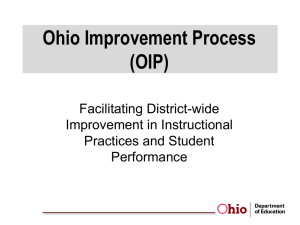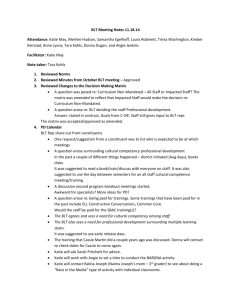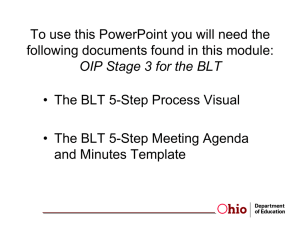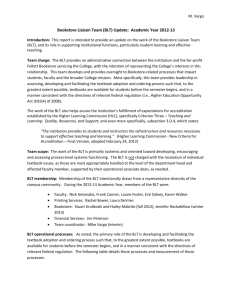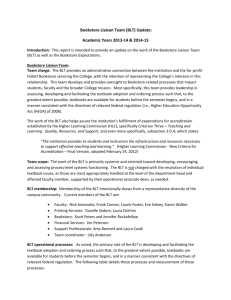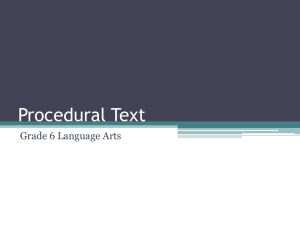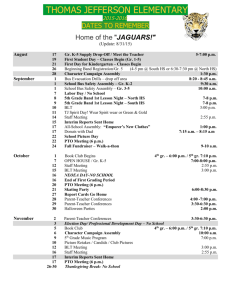BLT 5-Step Process Implementation Rubric
advertisement
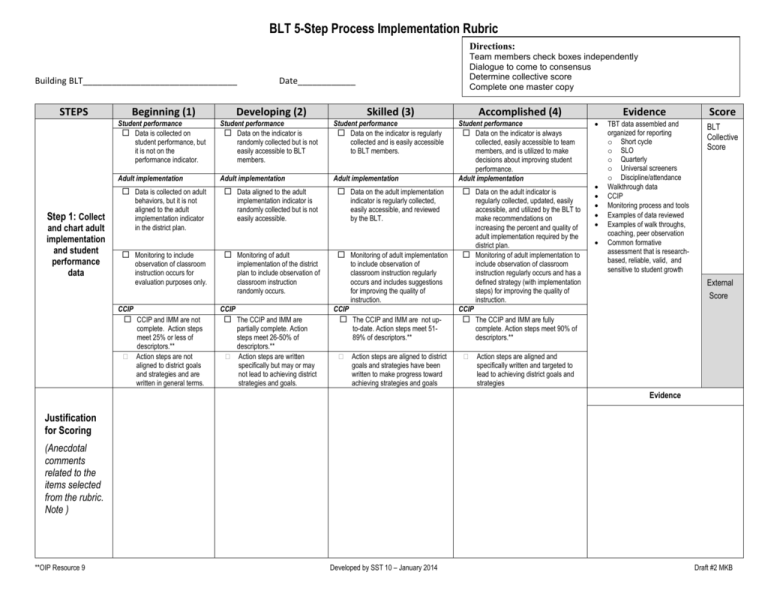
BLT 5-Step Process Implementation Rubric Directions: Building BLT________________________________ STEPS Beginning (1) Developing (2) Skilled (3) Student performance Data is collected on student performance, but it is not on the performance indicator. Student performance Data on the indicator is randomly collected but is not easily accessible to BLT members. Student performance Data on the indicator is regularly collected and is easily accessible to BLT members. Adult implementation Adult implementation Adult implementation Data is collected on adult Data aligned to the adult Data on the adult implementation Monitoring to include Monitoring of adult Monitoring of adult implementation behaviors, but it is not aligned to the adult implementation indicator in the district plan. Step 1: Collect and chart adult implementation and student performance data Date____________ observation of classroom instruction occurs for evaluation purposes only. CCIP implementation of the district plan to include observation of classroom instruction randomly occurs. CCIP CCIP and IMM are not implementation indicator is randomly collected but is not easily accessible. complete. Action steps meet 25% or less of descriptors.** Action steps are not aligned to district goals and strategies and are written in general terms. The CCIP and IMM are partially complete. Action steps meet 26-50% of descriptors.** Action steps are written specifically but may or may not lead to achieving district strategies and goals. indicator is regularly collected, easily accessible, and reviewed by the BLT. to include observation of classroom instruction regularly occurs and includes suggestions for improving the quality of instruction. CCIP The CCIP and IMM are not upto-date. Action steps meet 5189% of descriptors.** Action steps are aligned to district goals and strategies have been written to make progress toward achieving strategies and goals Team members check boxes independently Dialogue to come to consensus Determine collective score Complete one master copy Accomplished (4) Evidence Deter,ome cp;;ectove scpre Student performance TBT data assembled and ,aster cp organized for reporting Data- on theCp,[;ete indicatorpme is always collected, easily accessible to team members, and is utilized to make decisions about improving student performance. Adult implementation Data on the adult indicator is regularly collected, updated, easily accessible, and utilized by the BLT to make recommendations on increasing the percent and quality of adult implementation required by the district plan. Monitoring of adult implementation to include observation of classroom instruction regularly occurs and has a defined strategy (with implementation steps) for improving the quality of instruction. CCIP The CCIP and IMM are fully complete. Action steps meet 90% of descriptors.** o Short cycle o SLO o Quarterly o Universal screeners o Discipline/attendance Walkthrough data CCIP Monitoring process and tools Examples of data reviewed Examples of walk throughs, coaching, peer observation Common formative assessment that is researchbased, reliable, valid, and sensitive to student growth Score BLT Collective Score External Score Action steps are aligned and specifically written and targeted to lead to achieving district goals and strategies Evidence Justification for Scoring (Anecdotal comments related to the items selected from the rubric. Note ) **OIP Resource 9 Developed by SST 10 – January 2014 Draft #2 MKB BLT 5-Step Process Implementation Rubric STEPS Beginning (1) Student performance Accomplished (4) Student performance BLT discusses general BLT discusses high performing BLT identifies specific student strengths, areas BLT makes no connection BLT begins to recognize BLT occasionally makes connections BLT makes consistent connections between between the data being analyzed and the building and district’s strategies and actions. Adult implementation Step 2: Skilled (3) Student performance BLT discusses problem areas in grades/subject areas, skills or groups of students. Analyze adult implementation and student performance relative to the data Developing (2) Student performance concerns/weaknesses and strengths in grade/subject areas, skill/content areas, or groups of students. connections between the data being analyzed and the building and district’s strategies and actions. Adult implementation grade/subject areas, strong performance in skill/content areas, and areas of concern by grade/content based on data. between the data being analyzed and the building and district’s strategies and actions. Adult implementation BLT does not discuss adult BLT discusses generally adult BLT has no process for BLT discusses high performing strengths or areas of concern by grade levels, subject areas, etc. BLT discusses the possibility of replication, e.g., high performing TBTs, effective instructional strategies, etc. BLT begins to recognize BLT occasionally makes connections performance identifying points of possible replication, e.g., high performing TBTs, effective instructional strategies, etc. BLT makes no connection between the adult data being analyzed and the building and district’s strategies and actions. BLT develops feedback to TBTs relative to: BLT discusses adult performance performance as a building. TBTs, effective instructional strategies, etc. connections between the adult data being analyzed and the building and district’s strategies and actions. BLT develops feedback to TBTs relative to: between the adult data being analyzed and the building and district’s strategies and actions. BLT develops feedback to TBTs relative to: of concern, and points of possible replication, e.g., high performing grade/subject areas, strong performance in skill/content areas, etc. based on several clear data points. the data being analyzed and the building and district’s strategies and actions. Adult implementation BLT determines overall adult performance strengths and areas of concern by grade levels, subject areas, etc. BLT identifies points of possible replication, e.g., high performing TBTs, effective instructional strategies, etc. that are matched to student need based on data. BLT develops feedback to TBTs relative to: Growth areas of concern in student Growth areas and areas of concern in student General concerns about adult Growth areas of concern in adult Growth areas and areas of concern in adult Grade-levels, subject areas that are Grade-levels, subject areas that may be Procedures rather than datadriven decisions. performance of concern. performance performance and suggestions for improving the quality of instruction. performing well as well are those that are of concern External Score adult data being analyzed and the building and district’s strategies and actions. General concerns about student performance Score BLT Collective Score BLT always makes connections between the Decisions made during BLT meetings. Evidence BLT minutes Walk through data Process for identifying factors relating to high performance Process for identifying key data factors Process for identifying factors reflecting the gap between actual and expected performance performance. performance as well as defined strategies (with implementation steps) for improving the quality of instruction. Grade-levels, subject areas that have shown significant growth and may be worthy of replication. Evidence Justification for Scoring (Anecdotal comments related to the items selected from the rubric. Note ) **OIP Resource 9 Developed by SST 10 – January 2014 Draft #2 MKB BLT 5-Step Process Implementation Rubric STEPS Step 3: Review and/or refine the buildingfocused adult/student indicators relative to the data and TBT needs Beginning (1) BLT does not look at: o Adult implementation indicator(s) o Student performance indicators/assessment(s) used BLT suggests that individual teachers be allowed to determine how they will improve/change. BLT makes decisions randomly rather than based on data. Developing (2) Skilled (3) BLT reviews the following: BLT discusses revising the o Adult implementation indicator(s) o Student performance indicators (s)/assessment(s) used but does not consider the role of the BLT in making recommendations for change. BLT discusses the need for building-wide improvement/changes. BLT begins to look at data in a summative way. steps/details for achieving the following if needed: o Adult implementation indicator(s) o Student performance indicators (s)/assessment(s) used and shares that information with the TBTs. BLT identifies general expectations for improvement/changes. BLT looks at a variety of data and makes general recommendations based on that data. Accomplished (4) BLT develops or refines the steps/details for implementing/achieving the following if needed: o Adult implementation indicator(s) o Student performance indicators (s)/assessment(s) used and assists the TBT in implementing the steps as recommended. Evidence Score BLT minutes Refined list of “look fors” or implementation steps/details Revised assessments BLT Collective Score BLT determines specific expectations for External Score improvement/changes. BLT uses adult implementation and student performance data to drive the decisions necessary for building/district improvement. Evidence Justification for Scoring (Anecdotal comments related to the items selected from the rubric. Note ) **OIP Resource 9 Developed by SST 10 – January 2014 Draft #2 MKB BLT 5-Step Process Implementation Rubric STEPS Beginning (1) Step 4: BLT does not consider Establish building-wide implementation and monitoring action steps/tasks for Step 3 taking action on the execution of the action steps/tasks BLT determines that individual teachers be allowed to select their own professional development. BLT suggests that individual teachers and staff decide how best to implement the action steps. BLT suggests that teachers be reminded to address student needs in general. BLT does not consider whether or not administrator walkthroughs are tied to the strategies/actions. Developing (2) Skilled (3) BLT determines some tasks that BLT generates some ideas for how BLT suggests professional BLT makes suggestions about could be undertaken at the building level professional development/support that the building could provide that generally aligns to the plan. BLT makes some suggestions about how the staff will implement the action steps. the action steps/tasks will be executed, who will be responsible, and within what time frame. BLT determines the specific professional development/support that the district or building will provide that is specifically aligned to the plan. BLT determines specific steps for implementation of the action steps with fidelity. BLT suggests that the instructors BLT outlines possible ways for the BLT reviews the data to determine BLT suggests the continued use BLT reviews administrator walk- development/support that teachers can attend outside the district that may align to the plan. BLT suggests how the staff might implement the action steps. need to address student needs. of the walkthroughs. the action steps/tasks will be executed Accomplished (4) BLT makes specific determination of how instructors to address ALL students’ needs. throughs relative to effective, research-based instructional practices. Evidence Score BLT minutes PD plan Walk throughs TBT implementation selfassessment data PD surveys BLT Collective Score External Score strategies the instructors can implement to best match student needs and address the gap between actual and expected performance. BLT assures administrator walk-throughs are tied to the strategies/actions the district expects to be implemented and the TBTs have agreed to implement. Evidence Justification for Scoring (Anecdotal comments related to the items selected from the rubric. Note ) **OIP Resource 9 Developed by SST 10 – January 2014 Draft #2 MKB BLT 5-Step Process Implementation Rubric STEPS Beginning (1) Developing (2) Step 5: Define BLT does not believe the BLT agrees to look at some data adult and student data for review at next meeting data they need is available or reliable. BLT does not have a consistent form for the presentation of data. BLT inconsistently assigns roles and responsibilities. Skilled (3) at the next meeting but does not recommend any specific data for review. BLT offers suggestions about what data should be collected and how it might be collected. Accomplished (4) BLT determines the specific data to be collected, the person responsible for collecting it, and how it will be aggregated for the next meeting. BLT is unsure how the data BLT offers possible forms for BLT determines the form for presentation of BLT assigns someone to be BLT identifies possible person(s) BLT determines person(s) responsible for should be presented. responsible for collecting the data. presentation of the data. responsible who could collect and prepare the data. Evidence Score BLT data collection tools Examples of data collection processes BLT minutes the data. BLT Collective Score External Score collecting and preparing the data. Evidence Justification for Scoring (Anecdotal comments related to the items selected from the rubric. Note ) **OIP Resource 9 Developed by SST 10 – January 2014 Draft #2 MKB
